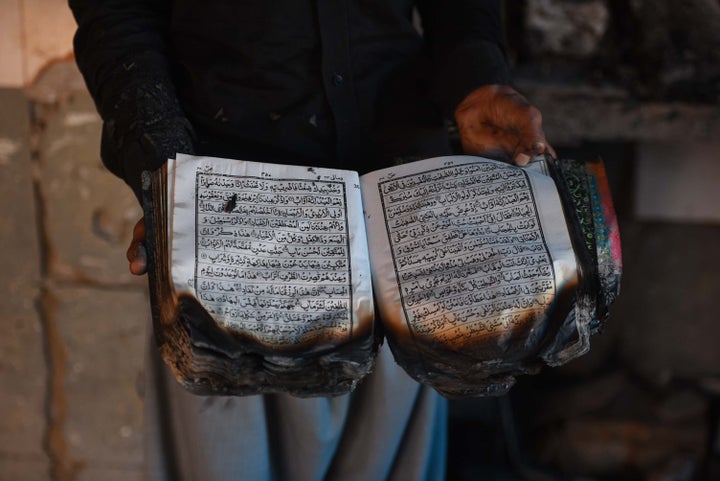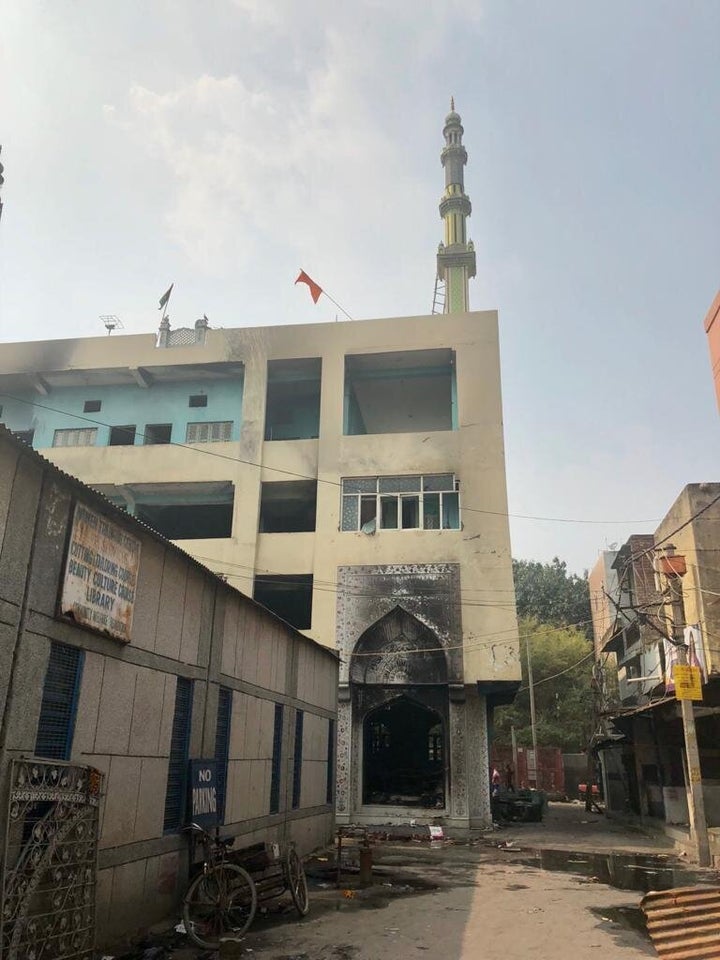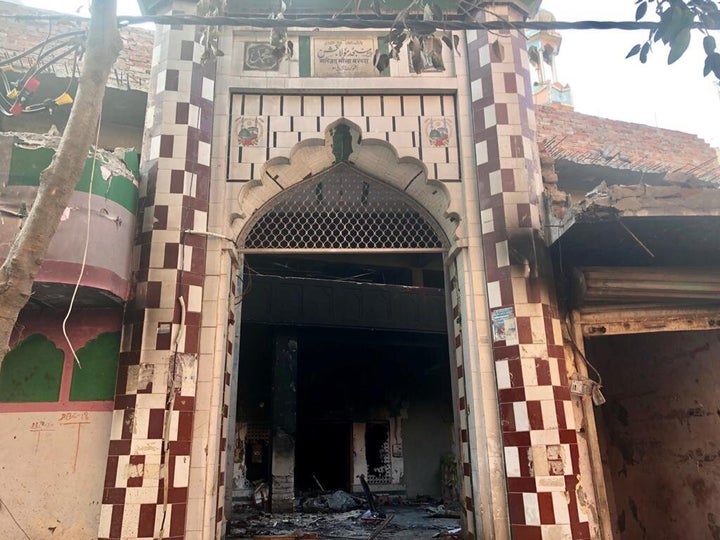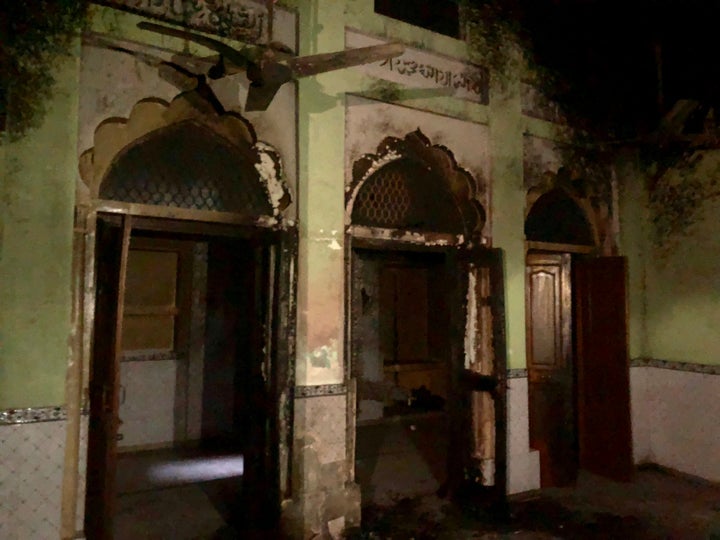
NEW DELHI — As graphic images of crowds of men rioting in the national capital lit up social media platforms this week, one particular clip stood out: A shaky cellphone video of a man planting a saffron flag atop the minaret of a mosque in Ashok Nagar, a neighbourhood in northeast Delhi.
For generations of Indians, both Hindu and Muslim, the image immediately evoked the iconic 1992 image of Rashtriya Swayamsevak Sangh (RSS) karsevaks atop the dome of Ayodhya’s Babri masjid, shortly before the moque was destroyed.
The destruction of Babri masjid set the stage for the transformation of Prime Minister Narendra Modi’s Bharatiya Janata Party (BJP) from a marginal party into the mainstream political force it is today.
This week’s attack on the Masjid Maula Baksh mosque in Ashok Nagar, barely weeks after the BJP suffered a landslide defeat in Delhi state elections, has crystallised what is seen as a now well-trodden path for Modi and his home minister Amit Shah.
On Wednesday, as the city continued to burn albeit on a lower flame, HuffPost India visited riot-hit neighbourhoods to find rioters had burnt and vandalised at least three mosques and one shrine, or mazaar, in Ashok Nagar, Gokalpuri and Chand Bagh. The Maulana Baksh mosque and Chand mosque in Ashok Nagar, the Jamia Arabia Madinatul Uloom mosque in Golakpuri, and the mazaar in Chand Bagh. This is not an exhaustive list; a report in The Wire noted that a fourth mosque had been burnt in Mustafabad. The Wire was the first publication to confirm the attack in Ashok Nagar.

The attacks on the mosques make clear that, irrespective of the impression that the clashes in the national capital were between those in support of or opposition to the controversial new Citizenship Amendment Act, the violence still simmering in New Delhi has assumed the shape of an outright communal riot.
These attacks on religious sites concretely establish how repeated speeches and incitement by the ruling BJP has turned the CAA and rumours of a proposed National Register of Citizens as a means to whip up Hindu sentiment against the spectre of foreign Muslim infiltrators, at a time when economic growth has ground to a standstill and the Modi government looks increasingly short of answers.
“We feel like there is a death in the family,” said Naseeruddin whose father built the Maulana Baksh mosque in Ashok Nagar in memory of Naseeruddin’s grandfather. “We had rented the first space to open a shop near the mosque to a Hindu in 1990. We did that in order to foster a secular feeling in the neighborhood.”
The seven shops around the Maulana Baksh mosque were also looted and set on fire.
“We feel like there is a death in the family.”

Mosques under attack
On the evening of Monday February 24, a rioting crowd attacked the Jamia Arabia Madinatul Uloom mosque in Gokalpuri — a northeast Delhi neighbourhood approximately a kilometer from the Gokalpuri metro station.
Kareem Khan, a businessman who fled Gokalpuri the next morning, said rioters attacked the mosque once on Monday evening and then returned in the night to wreak more destruction.
“I fled when a mob of around 30 people were running and chanting, ‘Jai Shri Ram. Get out Muslims.’” Khan said, who is now staying a kilometre away in the Muslim-majority neighborhood of Kardampuri. “Till that time, my (Hindu) neighbors had comforted us and said nothing would happen. But when I saw the locks on their doors, I knew they could not help us.”
Till it was torched, the Jamia Arabia Madinatul Uloom mosque built in 1978 was a touchstone for the local Muslim population who called it the Jannati masjid. When HuffPost India visited Gokalpuri on Wednesday morning, the mosque’s delicate marble inlay work is still visible on the scorched facades, while a saffron flag of conquest planted by the rioters still fluttered near its dome.
“There is nothing that hurts more than the destruction of our mosque.”
“There is nothing that hurts more than the destruction of our mosque,” Khan said. “This is a very beautiful, very ornate mosque from inside.”
As the riots continued on 25 February,
Mohammed Akbar Qureshi was barricaded in his home with his family when a gang of men kicked down his door and flung in a burning jute sack at about three in the afternoon. Ashok Nagar, where Qureshi lives, is just over two kilometers from Gokulpuri.
“It was hell,” Qureshi said. While his family cowered on the floor above, Qureshi ran down the stairs of his two storey house to stomp out the fire. Meanwhile, the rioters were looting and destroying his meat shops next door.
Qureshi had started calling the Jyoti Nagar Police Station when the Chand Mosque came under attack.
“We kept calling the police over and over again,” he said, his eyes welling up with tears. “They said they were reaching in two minutes. We called again and asked them to hurry. They said they were reaching, but nobody came to help us.”
“We kept calling the police over and over again.”
The Chand mosque built in 1986 is one of two mosques near Qureshi’s home in Ashok Nagar. The other is the Masjid Maula Baksh built in 1974 — the vandalism of which was caught in the now viral video. Both mosques, Ashok Nagar residents say, were attacked around the same time. All that is left on the inside are blackened walls and hundreds of charred pages from burnt copies of the Koran.
Mohammed Kamrauddin, who lives behind the Masjid Maula Baksh in Ashok Nagar, said that he lost track of how many times he called the Jyoti Nagar Police Station and begged for help.
The mob, he said, attacked the Masjid Maula Baksh, then the shops around the mosque, including a saloon, a shoe shop and a mobile phone shop, and then the Muslim homes in the locality.
“I have never felt fear like that. You know you could die, you imagine the worst ways they could kill you, but there is something inside of you that is fighting to stay alive,” Kamrauddin said. “We kept calling the police, but nobody came to help. We called so many times.”
“I have never felt fear like that.”
With the police unresponsive, and rioters now burning homes, Kamrauddin and his family leapt from their terrace onto the adjacent roof of another Muslim family. By this time, they had managed to reach a relative in the Delhi Police, who seemingly convinced someone at the Jyoti Nagar Police Station to send a jeep to rescue them.
“The police told us, ‘What can we do?’ When we said that our houses have been burned, they said, “Thank god, you have come out of this alive,” he said.
The rioters did not burn down Kamrauddin’s house, but only because his Hindu neighbours told them to stop. He surmises that his neighbourhoods did not want the fire spreading to their house.
But rioters looted everything of value including the jewellery and cash he had set aside for getting two of his daughters married. His losses, Kamrauddin said, were at least Rs.15 lakh.
“The police told us, ‘What can we do?'”

Neighbourhoods Divided
Kamaruddin and his family returned to their looted property on Thursday afternoon. When HuffPost India visited him on Wednesday, his Hindu neighbours came bearing tea, snacks and sympathy, which Kamaruddin accepted.
He showed them a room where there was nothing but clothes strewn all over the floor. Even the cylinders and utensils were stolen, he told them.
One neighbor said the Hindus would have helped, but they too were overwhelmed by the size and ferocity of the mob.
Kamaruddin said that he understood.
At least seven shops and five houses owned by or rented to Muslims were attacked and looted in Ashok Nagar.
When this reporter asked Kamaruddin if he intended to stay or move to a Muslim-dominated neighborhood, he said he was torn. His family had lived in Ashok Nagar for over 40 years, and got along just fine in the neighborhood. Leaving means a victory for the divisive forces that want to separate Hindus and Muslims, he said, but how could he risk staying and endangering his family.
“I don’t know what to do?” Kamaruddin said.
“I know it was a big and dangerous mob, but I can’t help but think that if the Hindu residents had all come out and told them to get lost, things would have been different,” he said.
“I don’t know what to do?”
Kareem Khan, who had fled from Gokalpuri, is facing a similar dilemma. The Sikh families in his neighbourhood, he said, rescued Muslim neighbours and ferried them to Muslim-dominated neighbourhoods nearby. He was in touch with his Hindu neighbours who were updating him about the status of his house.
“But I will always feel there is a risk if I go back,” he said. “I still have no problem with my neighbours but I don’t think I will feel the same way again.”
“I still have no problem with my neighbours but I don’t think I will feel the same way again.”
Qureshi, who has suffered losses worth Rs. 2 lakh, has no doubt that he will continue to live in Ashok Nagar. “I don’t know when this fear will go away, but this is home,” he said.
Naseeruddin is certain that his family will rebuild the mosque, which was on its third phase of renovation before it was demolished on 24 February.
“This mosque will become a marker of the riots in Delhi,” Naseeruddin said.
For the latest news and more, follow HuffPost India on Twitter, Facebook, and subscribe to our newsletter.